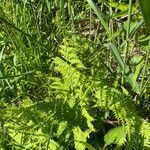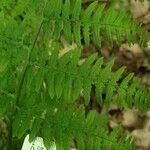Plants 35-65 cm tall. Rhizomes long creeping, black, glabrous or with sparse reddish brown, ovate-lanceolate scales. Fronds approximate; stipes 20-40 cm, bases black, distally dark stramineous, polished, usually glabrous, or white pubescent when young; laminae lanceolate, 22-28 × 6-9 cm or sometimes slightly wider, bases almost tapering, pinnate-pinnatifid, apices shortly acuminate and pinnatifid; pinnae ca. 20 pairs, subopposite, flat-or obliquely spreading, usually slightly reflexed; proximal pair slightly shortened, middle pinnae lanceolate, 4-5 × 1-1.2 cm, bases truncate, pinnatifid nearly to costae, apices shortly acuminate; segments 5-7 × 3-5 mm, rounded-obtuse or obtuse-pointed at apices, fertile segments usually recurved to forming points along margin. Veins pinnate in segments, lateral veins 4-6 pairs, simple or forked and reaching margins, proximal pair arising from base of costa. Laminae papery, grass-green or yellowish green when dry, glabrous on both surfaces, rachises and costae grooved adaxially, raised abaxially, glabrous on both sides or with acicular long hairs abaxially. Sori orbicular, dorsifixed at middle of veinlets, located between costa and margins; indusia small, orbicular-reniform, membranous, deciduous when mature. Spores smooth on surfaces of exospore, perispores translucent, echinate. 2n = 70.
More
A fern. It grows 60-90 cm high and wide. The rhizomes are creeping. The fronds are soft and grey-green. The fronds have long stalks and are sword shaped. They are divided. The sterile fronds are 40 cm long and the fertile fronds are 100 cm long. The fertile fronds have rows of spore bodies near the mid vein.





